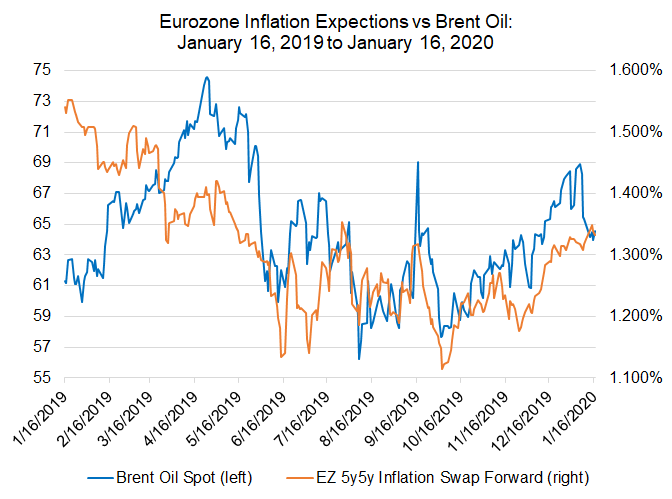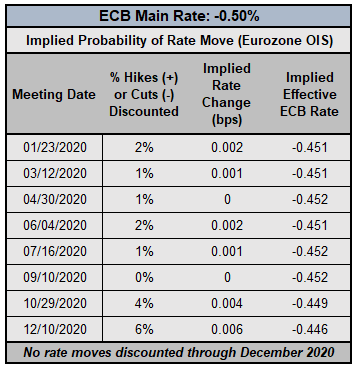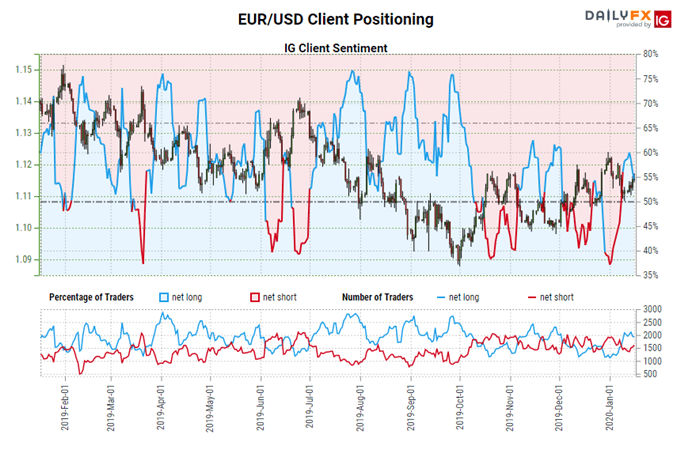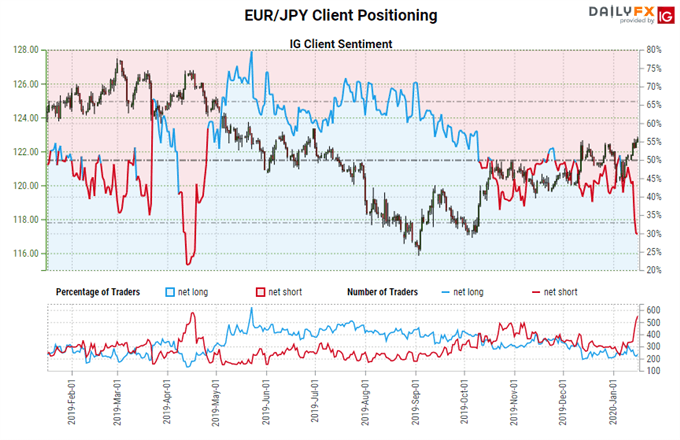Euro Forecast Overview:
- The Euro has been out of the spotlight at the start of the year thanks to the US-China trade war Phase 1 deal, US-Iranian geopolitical tensions, and the Brexit deadline.
- Eurozone economic data has been greatly improved in recent weeks, suggesting that the ECB may not need to ease further over the coming months.
- Per the IG Client Sentiment Index, EUR/JPY and EUR/USD have mixed trading outlooks.



Euro Struggling in December
The Euro has had a modestly positive start to January. Attention remains away from the Eurozone thanks to shifts in key macro themes, namely the US-China trade war Phase 1 deal, US-Iranian geopolitical tensions, and the Brexit deadline. The Euro has gained ground against four currencies while losing ground against three thus far. EUR/CHF is the worst performing pair, down by -0.84%, while EUR/AUD and EUR/GBP are leading the way higher, up by 0.98% each.
Eurozone Economic Data Continues to Improve
Euro strength at the start of 2020 has come in hand with an ongoing improvement in domestic Eurozone economic conditions. Eurozone economic data has improved in the past few weeks, at least when trying to measure releases relative to expectations. The Citi Economic Surprise Index for the Eurozone, a gauge of economic data momentum, currently sits at 40.5 today relative to 10.7 one-month ago on December 19 and –68.8 on October 17.
Eurozone Inflation Rises with Energy Prices
The Eurozone is faced with a situation where low growth and inflation expectations are keeping the ECB’s bias pointed towards easing. Yet new ECB President Christine Lagarde has pledged that the January meeting will feature the ECB’s policy review, which will provide a new course of policymakers have unanimity was broken by outgoing President Mario Draghi.
Eurozone Inflation Expectations versus Brent Oil Prices: Daily Timeframe (January 2019 to January 2020) (Chart 1)

The relationship between Eurozone 5y5y inflation swap forwards and Brent oil prices has been realigning since the start of Q4’19. The current 50-day correlation between Eurozone inflation expectations and Brent oil prices has increased from 0.46 on October 1 to 0.67 today. Weakness in short-term correlations (5-day, 20-day) have been exacerbated by the sharp pullback in energy prices amid deescalating US-Iranian geopolitical tensions.
ECB Review Period Keeps Rate Cuts at Bay
The ECB enters 2020 in a holding period. New ECB President Christine Lagarde will be using the early months of her tenure to find unanimity among policymakers after schism formed as a result of former ECB President Mario Draghi ramming through his easing package at the September ECB meeting. As policymakers search for a new consensus, it seems likely that the ECB will remain on the sidelines through much of 2020.
European Central Bank Interest Rate Expectations (January 16, 2020) (Table 1)

According to Eurozone overnight index swaps, traders are convinced that the period of recalibration by new ECB President Lagarde will take a very long time: there is only a 9% chance of a rate move through December 2020. Barring a significant deterioration in economic activity, it appears that the ECB, under President Lagarde’s stewardship, will be rather quiet during 2020.
EUR/USD RATE TECHNICAL ANALYSIS: DAILY CHART (January 2019 to January 2020 INTRADAY) (CHART 2)

EUR/USD rates remain in a broad ascending triangle dating back to August 2019, encompassed in a broader downtrend in place since May 2018. Accordingly, the outlook is appropriately neutral for longer-term traders.
For shorter-term traders, there may be opportunities within the ascending triangle – but more clarity is needed. EUR/USD rates are intermeshed within the daily 8-, 13-, and 21-EMA envelope and a daily candle is forming a bearish outside engulfing bar. Daily MACD continues to pullback while above its median line, and Slow Stochastics are turning while in bearish territory.
IG Client Sentiment Index: EUR/USD Rate Forecast (January 16, 2020) (Chart 3)

EUR/USD: Retail trader data shows 54.41% of traders are net-long with the ratio of traders long to short at 1.19 to 1. The number of traders net-long is 1.32% lower than yesterday and 0.90% higher from last week, while the number of traders net-short is 4.77% higher than yesterday and 6.89% higher from last week.
We typically take a contrarian view to crowd sentiment, and the fact traders are net-long suggests EUR/USD prices may continue to fall.
Yet traders are less net-long than yesterday and compared with last week. Recent changes in sentiment warn that the current EUR/USD price trend may soon reverse higher despite the fact traders remain net-long.
EUR/JPY RATE TECHNICAL ANALYSIS: DAILY CHART (January 2019 to January 2020 INTRADAY) (CHART 4)

EUR/JPY rates have been an impressive advance outside of the ascending triangle in place between August and early-December, carving out a bull flag upon the breakout. But now EUR/JPY rates have run into a key form of resistance, the rising trendline going back to the 2012, 2016, and 2019 swing lows. EUR/JPY rates are clearly at an important crossroads.
At present time, bullish momentum continues to build. EUR/JPY rates are above the daily 5, 8-, 13-, and 21-EMA envelope, fully in bullish sequential order. Daily MACD continues to rise while in bullish territory, while Slow Stochastics are hovering in overbought territory.
IG Client Sentiment Index: EUR/JPY Rate Forecast (January 16, 2020) (Chart 5)

EUR/JPY: Retail trader data shows 35.37% of traders are net-long with the ratio of traders short to long at 1.83 to 1. The number of traders net-long is 10.59% higher than yesterday and 9.38% lower from last week, while the number of traders net-short is 9.83% lower than yesterday and 58.47% higher from last week.
We typically take a contrarian view to crowd sentiment, and the fact traders are net-short suggests EUR/JPY prices may continue to rise.
Positioning is less net-short than yesterday but more net-short from last week. The combination of current sentiment and recent changes gives us a further mixed EUR/JPY trading bias.
--- Written by Christopher Vecchio, CFA, Senior Currency Strategist
To contact Christopher, email him at cvecchio@dailyfx.com
Follow him in the DailyFX Real Time News feed and Twitter at @CVecchioFX





